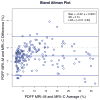Cross-sectional correlation between hepatic R2* and proton density fat fraction (PDFF) in children with hepatic steatosis
- PMID: 28543915
- PMCID: PMC5702271
- DOI: 10.1002/jmri.25748
Cross-sectional correlation between hepatic R2* and proton density fat fraction (PDFF) in children with hepatic steatosis
Abstract
Purpose: To determine the relationship between hepatic proton density fat fraction (PDFF) and R2* in vivo.
Materials and methods: In this Health Insurance Portability and Accountability Act (HIPAA)-compliant, Institutional Review Board (IRB)-approved, cross-sectional study, we conducted a secondary analysis of 3T magnetic resonance imaging (MRI) exams performed as part of prospective research studies in children in whom conditions associated with iron overload were excluded clinically. Each exam included low-flip-angle, multiecho magnitude (-M) and complex (-C) based chemical-shift-encoded MRI techniques with spectral modeling of fat to generate hepatic PDFF and R2* parametric maps. For each technique and each patient, regions of interest were placed on the maps in each of the nine Couinaud segments, and composite whole-liver PDFF and R2* values were calculated. Pearson's correlation coefficients between PDFF and R2* were computed for each MRI technique. Correlations were compared using Steiger's test.
Results: In all, 184 children (123 boys, 61 girls) were included in this analysis. PDFF estimated by MRI-M and MRI-C ranged from 1.1-35.4% (9.44 ± 8.76) and 2.1-38.1% (10.1 ± 8.7), respectively. R2* estimated by MRI-M and MRI-C ranged from 32.6-78.7 s-1 (48.4 ± 9.8) and 27.2-71.5 s-1 (42.2 ± 8.6), respectively. There were strong and significant correlations between hepatic PDFF and R2* values estimated by MRI-M (r = 0.874; P < 0.0001) and MRI-C (r = 0.853; P < 0.0001). The correlation coefficients (0.874 vs. 0.853) were not significantly different (P = 0.15).
Conclusion: Hepatic PDFF and R2* are strongly correlated with each other in vivo. This relationship was observed using two different MRI techniques.
Level of evidence: 2 Technical Efficacy: Stage 1 J. Magn. Reson. Imaging 2018;47:418-424.
Keywords: MRI; PDFF (proton density fat fraction); R2*; children; hepatic steatosis; iron overload.
© 2017 International Society for Magnetic Resonance in Medicine.
Figures





References
Publication types
MeSH terms
Grants and funding
LinkOut - more resources
Full Text Sources
Other Literature Sources
Medical
Molecular Biology Databases
Research Materials

